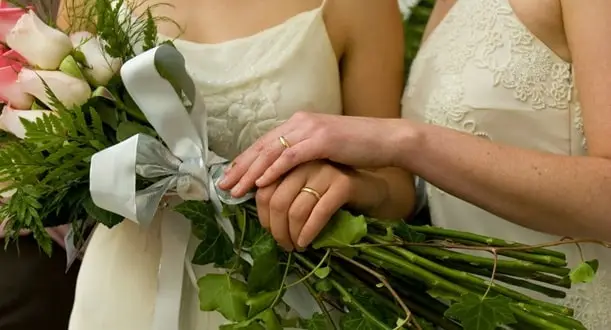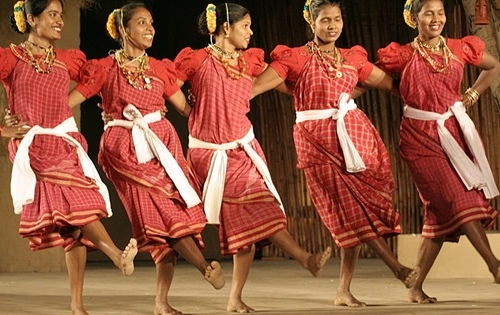Gujarat, a land of colorful traditions, lively festivals, and deep-rooted cultural heritage, is home to some of India’s most energetic and vibrant dance forms. Known for its festive spirit and artistic excellence, the traditional dances of Gujarat reflect the state’s history, religious customs, and social life.
These dances are an integral part of Navratri celebrations, harvest festivals, weddings, and community gatherings, performed with traditional music, folk songs, and rhythmic beats of the dhol. The lively movements, synchronized steps, and colorful attire make Gujarati folk dances a visual delight.
Let’s explore the most famous traditional dance forms of Gujarat, their origins, and their significance in Gujarati culture.
1. Garba – The Iconic Dance of Gujarat
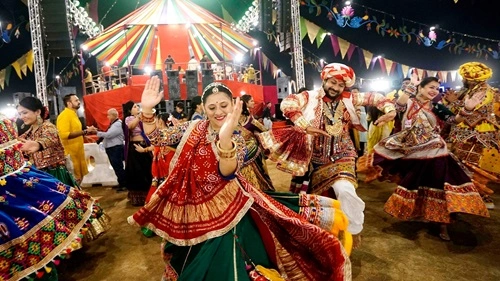
One of the most popular and internationally recognized dance forms of Gujarat, Garba is a circular folk dance performed in devotion to Goddess Amba (Durga) during Navratri.
- Features: Circular formations, rhythmic claps, graceful twirls, and synchronized steps.
- Themes: Devotion to the Goddess, joy, and celebration of womanhood.
- Occasions: Navratri, weddings, and religious festivals.
Dancers wear traditional attire, with women dressed in chaniya choli, adorned with mirror work and embroidery, while men wear kurta-pyjamas with kedia (jacket-like tops). The music, featuring dhol, harmonium, and folk songs, creates an electrifying atmosphere.
Garba has gained global recognition, with Gujarati communities performing it worldwide, making it a symbol of Gujarati culture.
2. Dandiya Raas – The Energetic Stick Dance
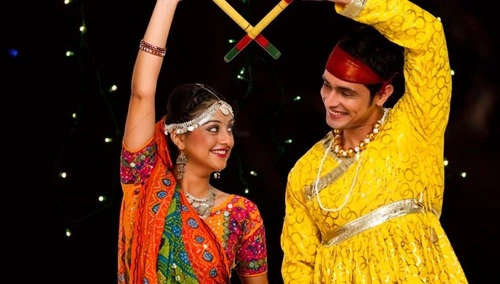
Often performed alongside Garba, Dandiya Raas is a high-energy stick dance, where dancers use decorated wooden sticks (dandiyas) to create rhythmic beats.
- Features: Fast footwork, paired formations, and energetic dandiya clashing.
- Themes: Krishna’s playful Raas Leela, devotion, and celebration.
- Occasions: Navratri, social gatherings, and weddings.
Inspired by Lord Krishna’s Raas Leela with the Gopis, Dandiya Raas is a major attraction during Navratri and showcases Gujarat’s festive spirit and community bonding.
3. Tippani Dance – The Dance of Hardworking Women
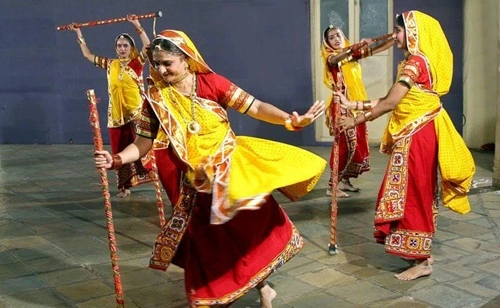
Tippani dance originated among the working-class women of Gujarat, particularly in the Saurashtra region. It was performed to relieve stress while working in construction and farming.
- Features: Women use long wooden sticks (Tippanis) to strike the ground in rhythm.
- Themes: Hard work, unity, and women’s empowerment.
- Occasions: Festivals and social celebrations.
Tippani is a unique blend of strength and grace, where women dance in harmony while creating beats with their sticks, showcasing the resilience and unity of Gujarati women.
4. Bhavai – The Theatrical Folk Dance
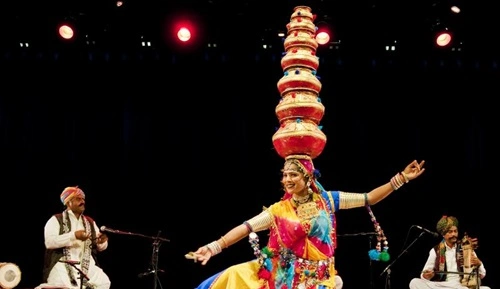
Bhavai is a traditional folk theatre dance-drama, performed with a mix of dance, acting, and storytelling. Originating in the medieval period, it narrates social issues, historical events, and mythological tales.
- Features: Acrobatics, exaggerated expressions, humorous dialogues, and storytelling.
- Themes: Hindu mythology, social issues, and folk legends.
- Occasions: Religious fairs, temple festivals, and cultural programs.
Bhavai is performed in temples and open-air arenas, keeping Gujarati folk traditions and storytelling alive.
5. Padhar Dance – The Dance of the Fishermen
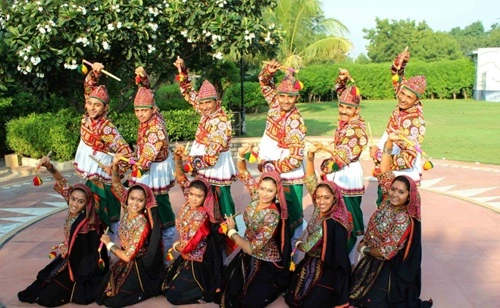
The Padhar community, known for its fishing and water-centric lifestyle, performs the Padhar dance to depict fishing activities, water movements, and nature’s beauty.
- Features: Swaying hand gestures resembling waves, boats, and fishing nets.
- Themes: Connection with nature, water worship, and community bonding.
- Occasions: Monsoon festivals and village fairs.
Dancers wear traditional white attire with turbans, performing graceful and synchronized steps that mimic the flow of water
6. Hudo Dance – The Tribal Dance of Gujarat
Performed by the Bharwad (shepherd) community, Hudo dance is a tribal war dance that showcases strength, agility, and unity.
- Features: Fast footwork, circular formations, and enthusiastic hand movements.
- Themes: Tribal unity, bravery, and celebration of victories.
- Occasions: Harvest festivals, Holi, and tribal fairs.
Hudo dance is a raw and energetic dance, representing tribal courage and camaraderie.
7. Sidi Dhamal – The Dance of the African Sidi Community
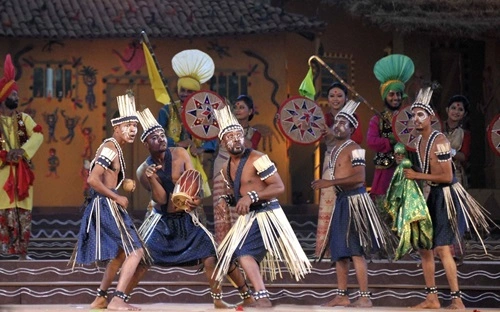
The Sidi community, descendants of African immigrants, perform the Sidi Dhamal dance, a powerful and rhythmic dance accompanied by dhamal drums and chants.
- Features: High-energy jumps, drum beats, and ecstatic body movements.
- Themes: Worship, spiritual trance, and community unity.
- Occasions: Religious gatherings, Sidi festivals, and cultural events.
This dance showcases the unique Afro-Gujarati cultural fusion, making it one of Gujarat’s most distinctive traditional dances.
8. Dangi Dance – The Dance of the Dang Tribe
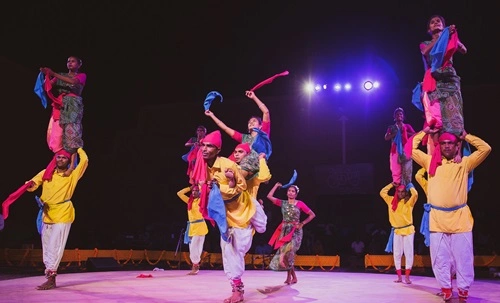
The Dangi tribal community, residing in South Gujarat, performs the Dangi dance, a lively and artistic folk dance.
- Features: Interlocking arm movements, rhythmic footwork, and group formations.
- Themes: Nature worship, celebration of tribal unity, and warrior spirit.
- Occasions: Harvest festivals and tribal fairs.
This dance symbolizes strength and coordination, often performed in snake-like formations.
9. Mer Raas – The Warrior Dance of Gujarat
The Mer community, known for its warrior heritage, performs Mer Raas, a dance that depicts battle strategies and martial techniques.
- Features: Sword fighting, warrior formations, and powerful movements.
- Themes: Bravery, heroism, and warrior traditions.
- Occasions: Historical commemorations and fairs.
This dance form is a reminder of Gujarat’s valorous past, showcasing traditional martial arts and self-defense techniques.
Conclusion
The traditional dances of Gujarat are a reflection of its rich cultural, historical, and social fabric. From the graceful Garba and energetic Dandiya Raas to the martial Mer Raas and tribal Hudo dance, each dance form is a symbol of Gujarati pride and heritage.
These dances continue to flourish and evolve, celebrated at local festivals, national events, and international platforms, keeping Gujarati traditions alive for future generations. Whether performed in temples, villages, or global festivals, Gujarat’s folk dances remain a testament to its artistic and cultural excellence, captivating audiences worldwide.
